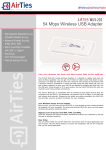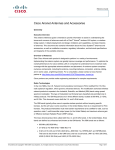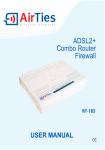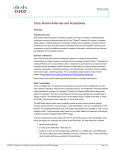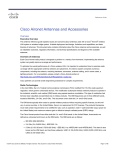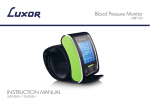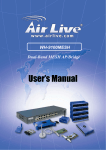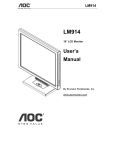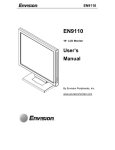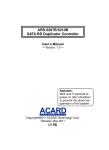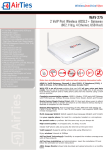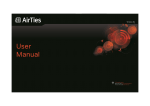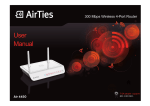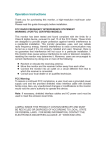Download USER MANUAL
Transcript
Kablosuz yaşam Wireless Kit / Wireless Network Extender USER MANUAL AirTouch Air 4420 24/7 people support 0845 557 5782 (from United Kingdom) +90 212 444 0239 (International) Three yea Manual Overview 3 1. INTRODUCTION 3 3.2.1 Connecting to your device 18 Safety and Maintenance 3 1.1 Minimum System Requirements 3 3.2.2 Wireless Network Settings 18 1.2 Package Contents 3 3.2.3 Wireless Security Settings 19 1.3 Front Panel 4 3.2.4 MAC Filtering 20 1.4 Back Panel 5 3.2.5 AirTies Mesh Settings 21 1.5 Main Features 5 3.3 Management 22 2 INSTALLATION 5 3.4 UPNP 22 2.1 Cabling 5 3.5 USB Devices 23 2.2 Setup 5 3.6 Media Server 23 2.3 Advanced setup using AirTies Network 3.7 Tools 24 Assistant 6 3.7.1 Firmware Update 24 2.3.1 Installation 6 3.7.2 Time Setting 24 2.3.2 Running 8 3.8 Report 24 AirTies Network Assistant 8 3.8.1 System Logs 25 9 2.3.3 Network Display 3.8.2 Log Settings 25 2.3.4 Change Node Name 10 4 TECHNICAL PROPERTIES 26 2.3.5 Show Properties 10 5 PHYSICAL CHARACTERISTICS 26 2.3.6 Wireless Settings 10 2.3.7 USB Status 11 2.3.8 Firmware Upgrade 11 2.3.9 User Info 11 2.3.10 USB Host 12 2.3.10 .1 USB Disk 12 2.3.10.2 USB Printer 12 2.3.11 Troubleshooting 13 2.3.12 Adding AirTies Devices 14 3 ADVANCED SETTINGS 14 3.1 LAN Settings 14 3.1.1 IP and DHCP Settings 14 2.1.2 LAN Clients 16 3.1.3 VLAN Configuration 17 3.1.4 Port Configuration 18 3.2 Wireless Settings 18 2 wireless network. AirTies Mesh Technology is used for this purpose. The AirTies Mesh Technology resolves problems such as loss of wireless signal or limited coverage area often encountered in multiple-story or reinforced concrete buildings. To extend your wireless coverage, all you need to do is to add new Air 4420 devices to your wireless network and add them to the Mesh network. Computers on the network connect to the Air 4420 with the strongest signal and reach the router on the wired network through the Mesh network. This manual has been prepared by AirTies Wireless Networks Corporation. All rights reserved. Manual Overview This manual guides you through the steps necessary for setting up and configuring your AirTies device. Please read this manual carefully before beginning the installation process. Using two Air 4420s, devices such as TVs, Set Top Boxes and games consoles can be connected to the router by creating a wireless bridge between the two Air 4420s. The Warranty does not cover failure or damage as a result of not following the instructions in the manual. AirTies will not be held responsible in such circumstances. The User Manual is an important resource you can refer to for safe and proper use of your device. Please retain it for future reference. 1.1 Minimum System • Safety and Maintenance • • • • • • • • • 1. INTRODUCTION In order to prevent damage to your device, be sure to keep it in its original box during transportation. The device must be used solely with its original power adapter. Please note that the adapter is 220V only. Do not use with 110V AC. Do not insert a PSTN (phone) plug into the LAN port. If you encounter any problems, do not open or disassemble the device. Call AirTies Technical Support. In order to prevent electric shock, do not operate the device in wet or damp areas. In the event of a gas leak, do not use the device. Do not turn the device on or off. Do not plug or unplug the power cord. Avoid using the device in dusty environments. If dust buildup should occur, use a dry cloth to remove the dust. To clean the exterior of the device use a dry cloth. Do not attempt to clean the interior. There are no user serviceable components inside. For information regarding the installation and configuration of the device consult the remainder of this manual. The average usage life of the device is 7 years as determined by the Authority of Industry and Trade. • • For installation an existing router is required. For the AirTies Network Assistant utility a PC is required running Windows XP (Service Pack 2 and above), Windows Vista or Windows 7. Requirements 1.2 Package Contents Please check to make sure the parts below are in the box: For Air4420-TV, Air4420-STB, Air4420-GA 1. Two Air4420s 2. Two 12V Power Supplies 3. Two Ethernet Cables 4. One Easy Setup CD 5. One Quick Installation Guide 6. One Warranty Card and Certificate of Compliance 1 2 The AirTies Air 4420 is an IEEE 802.11b/g/n compliant, 300 Mbps wireless communication device that can be used as a wireless access point, repeater or as a bridge (using two Air 4420s). As a repeater, the Air 4420 makes it possible to extend the coverage area of a Wireless llife Wireless life One touch setup Simple & easy to use You can connect the AirTies Air 4420 to a wired modem or router through the Ethernet port to setup a wireless local network and enable wireless computers to access the Internet. 4 Three year warranty Lifetime enjoyment 7/24 people support +90 212 444 0 239 Quick Installation Guide 3 6 Warranty Card 5 3 1.3 Front Panel For Air 4420 1. One Air4420 2. One 12V Power Supplies 3. One Ethernet Cables 4. One Easy Setup CD 5. One Quick Installation Guide 6. One Warranty Card and Certificate of Compliance LED LIGHT STATUS Power Blue The device is ON Off The device is OFF Red LAN connection established and active Red Flashing LAN connection active. There is data exchange Off No LAN connection Red Wireless network connection established and active Red Flashing Data exchange on the wireless network connection Off No wireless network connection Red Connection to USB device is established Off Connection to USB device not established Ethernet 1 2 3 Wireless llife Wireless life Wireless One touch setup Simple & easy to use Quick Installation Guide 4 Three year warranty Lifetime enjoyment 7/24 people support +90 212 444 0 239 5 6 Warranty Card USB 4 1.4 Back Panel 2 INSTALLATION First complete the cabling process as shown in the diagram. 2.1 Cabling 1.Using the black Ethernet cable, connect one Air 4420 to your existing gateway. Make sure your gateway is turned on. 2.Using the black Ethernet cable, connect the other Air 4420 to your TV, set-top box or games console. 3.Connect the power adapters inside the box to the power sockets of each Air 4420 and plug into electric sockets. 4.Turn on both Air 4420s by switching the On/Off button to position “1”. Power Switch Move to | position to power device 12 V Power Port 12 V power. Connects to power adapter Ethernet Port Ethernet port Reset Button Use to restore factory defaults USB Port Connect to USB disks and printers to share on network 2.2 Setup 2 To reset the device use a sharp object to press and hold the button while the device is turned on. 1.5 Main Features Multi-function: Access Point, Repeater, Bridge, Router USB Plug & Share : This feature allows for printers and disks to be shared on the network.* Media Server: Play media from an attached USB disk on a UPnP AV / DLNA compliant Media Player. * Advanced Wireless Security: WPA2-PSK, WPA2-802.1x, WPA-PSK, WPA802.1x, WEP wireless encryption standards supported. 24 / 7 Technical Support: AirTies Call Centre provides access to technical specialists. 3 Year Extended Warranty: 1 3 *Available on Air 4420-TV, Air 4420-GA and Air 4420 products.INSTALLATION FROM QIG –AIR 4420-TV Exclude AirTies Network Assistant and Media Server installation section. 5 2.3 Advanced setup using AirTies Network Assistant AirTies Network Assistant is an application that will setup and configure, monitor and manage home networks. It has been specifically designed to enable non technical users to perform tasks that are important to effectively managing the home network. Your AirTies product will be provided with a CD that contains the AirTies Network Assistant application. Alternatively you can download the latest version from www.airties.com. AirTies Network Assistant can be installed on as many PCs as you would like and can also be used to monitor networks that do not contain AirTies devices, although many key features will be missing because they require AirTies devices. 2.3.1 Installation During AirTies Network Assistant installation your AirTies device will be setup and configured. Insert the CD that came with your AirTies device into the CD ROM drive of your PC, after a few seconds the animation will run (see below). Select the product category and product that you want to configure from the menu. Follow the animation showing how to configure the cabling of the product. Ensure that you following the cabling for your product in according to the animation. After cabling animation has completed AirTies Network Assistant is installed: Once AirTies Network Assistant has completed installation the setup program will run: AirTies Network Assistant is an application that will setup and configure, monitor and manage home networks. It has been specifically designed to enable non technical users to perform tasks that are important to effectively managing the home network. Your AirTies product will be provided with a CD that contains the AirTies Network Assistant application. Alternatively you can download the latest version from www.airties.com. AirTies Network Assistant can be installed on as many PCs as you would like and can also be used to monitor networks that do not contain AirTies devices, although many key features will be missing because they require AirTies devices. 6 During AirTies Network Assistant installation your AirTies device will be setup and configured. Insert the CD that came with your AirTies device into the CD ROM drive of your PC, after a few seconds the animation will run (see below). Select the product category and product that you want to configure from the menu. Follow the animation showing how to configure the cabling of the product. Ensure that you following the cabling for your product in according to the animation. After cabling animation has completed AirTies Network Assistant is installed: Click Next to setup your device.If your device and PC supports AirTouch then you will be prompted to press the button on your device to initialise AirTouch: Once AirTies Network Assistant has completed installation the setup program will run: Press the AirTouch button on your AirTies device and click the AirTouch button. A secure connection will be initialised between the AirTies device and PC 7 running AirTies Network Assistant, which includes an automatically generated wireless key. Once the wireless connection has been created and the device configured the wireless security key is displayed. Copy this if you want to share the connection with other non Windows 7 devices. Select WPA/WPA2 as the Security Mode. This is the highest level of security that you can configure. Enter a Wireless Network Name (SSID). This is the name that appears when you search for wireless networks from a PC. Enter a password for the wireless network. This should be at least eight characters long. You can see the characters by unchecking Hide characters. Click Next . If your AirTies device does not support AirTouch then you will be prompted to configure the wireless security manually for your device: 2.3.2 Running AirTies Network Assistant The AirTies Network Assistant application will always run in the background and can be accessed by clicking the AirTies logo in the notification area (bottom left corner, next to the clock). AirTies Network Assistant starts every time the PC starts, allowing for the network to be continually monitored. If you want to exit AirTies Network Assistant then you must right click the AirTies logo in the notification area and select “exit”. If AirTies Network Assistant is not running and you want to run it then you must select the AirTies Network Assistant application from the start menu under All Programs > AirTies Wireless Networks > AirTies Network Assistant. 8 2.3.3 Network Display The network display is the central component of AirTies Network Assistant. Here all devices on the network are displayed with information about each device, status of network connection and problems with the network. Once AirTies Network Assistant has been installed and the connection between your PC and your AirTies device has been configured then the network display will be shown to the user. For normal usage when AirTies Network Assistant starts the network display will be shown. The network map should be updated automatically as new devices are added to the network. However, if the network map is not accurate then a manual refresh can ran by clicking the refresh button on the top right of the screen. Each AirTies product will be displayed with their image on the network map. Non AirTies devices will be displayed with a generic image. It is not possible to manage non AirTies devices but the network can still be displayed on AirTies Network Assistant. Your router device is the device that has a connection to the Internet. It is the device that connects the home network to the Internet and is usually a gateway device such as an ADSL modem. There should only be one routing device on your network and this device is placed in the middle of the AirTies Network Assistant network display. From the router device the Internet and local network device are connected. A green line indicates that a device is connected. A red line indicates that a device is not connected. As new devices are added to the network they will appear on AirTies Network Assistant. If a device is removed from the network then it will disappear from the network GUI after it has been disconnected for four hours. Dotted lines indicate a wireless connection and non dotted lines indicate a cable connection. Any devices that are present on your network map but that you do not know should be investigated. Enabling wireless security or changing existing wireless security (see below) will ensure that intruders cannot continue to access your network. Clicking an AirTies device allows for configuration to be updated. A red cross on the line indicates that there is a problem. Clicking this will launch the trouble shooter application, which will identify the problem and attempt to solve it. 9 2.3.4 Change Node Name Each device has a name, which is either the host name or the IP address. The node name can be updated to make it easier to keep track of devices on the network. For example, a games console may show on the network map as an IP address like 192.168.2.55 but can be renamed to be “games console 1”. 2.3.5 Show Properties The properties can be displayed for each device. Properties for AirTies devices are displayed: Properties for local computer running AirTies Network Assistant are displayed: 2.3.6 Wireless The wireless settings of the device can be changed: Settings The security mode can be changed to either None or WPA/WPA2. The Wireless Network Name (SSID) can be changed. This is the name that appears when you search for wireless networks from a PC. The password used to connect to the wireless network can be changed. This should be at least eight characters long. You can see the characters by unchecking Hide characters. Click OK to save your settings. Click Advanced to show all Internet settings. 10 Click Cancel to cancel any changes made and return to the network map. Note that for devices that are connected via MESH changes made to the gateway will be propagated to all devices connected via MESH. 2.3.7 USB Status USB status shows whether a printer or USB disk is inserted into the device. For disks the amount of free disk space is displayed: If no firmware was found then the user will be informed: For printers the printer model is displayed: If new firmware is discovered then the firmware on the device will be updated. 2.3.8 Firmware Upgrade AirTies Network Assistant will automatically check for new firmware updates for devices. If new firmware is available then an icon will be displayed on the device to let the user know that there is new firmware available. Clicking on the icon will perform a firmware upgrade on the device. A manual update can also be made by selecting Firmware Upgrade. A check will be made for new firmware: For the local PC there is a software upgrade option instead of firmware upgrade. This will check for any newer versions of AirTies Network Assistant and update if the user requests. 2.3.9 User Info Registering a device provides AirTies with useful information that we use to help the customer with if they have a problem and also use to help us improve our products and customer experience. Each AirTies device on the home network can be registered with AirTies. 11 Clicking the USB disk icon will open an explorer window showing the drive contents 2.3.10.2 USB Printer If a USB printer is attached to your AirTies device then a printer icon will appear next to your AirTies device on the network map. If a user does want to register then they can select Do not register from the drop down box. Click OK to save your settings. Click Cancel to cancel any changes made and return to the network map. Advanced settings open the devices’ Web configuration page and allow for all other settings to be updated by the user (see settings below). 2.3.10 USB Host 2.3.10 .1 USB Disk If a USB disk is attached to your AirTies device then a USB drive icon will appear next to your AirTies device on the network map. Clicking the icon will install a printer on your PC. Note that you must have the printer drivers installed on yor PC, please install the prinet to your PC using instrucstions and software from the printer manufacturer. Click Next to install the printer. 12 2.3.11 Troubleshooting AirTies Network Assistant automatically detects problems on the home network and attempts to solve this issues with the Troubleshooting application. When the connection between the PC and gateway or between the PC and Internet is cut off then the network map shows the network link with a cross, to indicate that that there is a problem: Ensure that the printer is connected to the device and click Next The printer will be created as a Windows printer. Click Print Test Page to test that the printer has been successfully setup. Cick Finish to finish. When you print from to the Windows printer on your PC it will print to the printer connected to your AirTies device. Clicking on the red cross initiates the troubleshooting application. The application will determine what the problem appears to be: The troubleshooting application will try and resolves the problem. The user will be prompted with the proposed solution and asked if they are required to carry out an action. For example, below the solution is for the user to turn on the wireless switch on their PC. 13 3 ADVANCED SETTINGS From the AirTies Network Assistant network diagram you can open the advanced settings of your device by clicking your device on the network diagram and selecting Advanced Settings. Accessing Advanced Settings with a Static IP Once the network connection has been restored troubleshooting closes. Troubleshooting has been designed to solve all the major problems that user may typically face. Troubleshooting may be automatically executed during setup. 2.3.12 Adding AirTies Devices When another device is added to the network then it will be displayed in the network map. If the new device is an AirTies device then the user s prompted to register the device. The user can choose not to register the device, register as a new user or use an existing user’s details that already has devices registered to them on the network. Clicking OK resisters the new device. Clicking Cancel closes the prompt. 3.1 LAN Settings 3.1.1 IP and DHCP Settings By default the your device is configured to get an IP address from a gateway on the Internet. If no DHCP (Dynamic Host Configuration Protocol) server can be found on the network then the device will default to the IP address of 192.168.2.154. You can configure the IP and DHCP Settings of your device, from the IP and DHCP Settings submenu under the LAN menu. Click Edit to change the DHCP settings. 14 Enable DHCP Server The DHCP Type can be changed as follows: Off DHCP Server DHCP Relay Agent DHCP Client Disable DHCP ( Off ) DHCP Server mode configures the device to assign IP addresses to connecting devices. There must only be one DHCP Server on the network, which in most cases will be the router. No DHCP is used. The device must be manually assigned an IP address. To disable DHCP select Off and enter an IP address and Netmask. Click Save to save your settings. DHCP is enabled by default. In this section you can assign an address range from which your device can assign local IP addresses to clients and the lease time. The default IP address range is 192.168.2.2 through 192.168.2.254. Maximum lease time for an assigned IP address is set as 3600 seconds, which means the assigned IP address will be renewed every 3600 seconds. To configure the device as a DHCP server select DHCP Server and enter an IP address, Netmask, DHCP Server Name, Start and End addresses that will be assigned devices, Netmask, Gateway Address, Lease Time, DNS Address. Click Save to save your settings. 15 Enable DHCP Relay Enable DHCP Client Agent DHCP relay makes it possible for a DHCP server on a different network to assign local IP addresses to clients connected to your device. To enable this, the address of the device (modem, server etc) that runs the DHCP service needs to be known. If DHCP Relay is enabled the DHCP server on your device is disabled and cannot assign IP addresses to clients. To configure DHCP Relay Agent select DHCP Relay Agent and enter an IP address for the device, DHCP Server name and address of the DHCP Server. Click Save to save your settings. DHCP client mode configures the device to obtain an IP address from a DHCP server on the network. To enable DHCP client select DHCP Client. Click Save to save your settings. 2.1.2 LAN Clients If the device is configured as a DHCP server then you can see a list of all the clients connected to the device. Select LAN Client under the LAN menu of the Web Interface. Through this menu, you can also reserve an IP address for a client. When an IP address is reserved for a client, it cannot be assigned to any other client. Whenever the client connects to the router, it gets the IP address reserved for it. Click the reserve button next to a dynamic address to reserve this as a static address. 16 You can see the IP addresses that are reserved in the “Static Addresses” table. “Dynamic Addresses” table shows the IP addresses assigned but not reserved. To new static address click “New”. Enter the Name, MAC Address, IP Address and select the LAN. Click save to create the new static address. A list of VLANs will be shown. By default there will be a single VLAN named VLAN 1. This is the entire network. To create a new VLAN click New VLAN. Enter a VLAN Name and VLAN Id for the new VLAN. Select the ports that you want to add to the VLAN (Ethernet ports, wireless ports). Click Save to save your changes. To add or remove ports from the VLANs select Edit from the main VLAN menu for the VLAN that you want to update. 3.1.3 VLAN Configuration Virtual Local Area Networks (VLANs) separate a single physical network into multiple logical networks. A reason why you may create a VLAN is if you want to separate your network for security reasons, your guests can use one VLAN and you can use another. By default the device is configured to operate over a single VLAN.. To configure VLANs select VLAN Configuration under the LAN menu. From the list of selectable ports select the port that you want to add and click >>. Select Save to save your changes. Note that a port can only be a member of one VLAN at any time so if you want to add a port to a VLAN you must first remove it from any VLAN that it is currently configured to use.Port Configuration 17 3.1.4 Port Configuration Tags can be configured on each port to allow data to be separated to different VLANs. Select Port Configuration from the LAN menu. 3.2.2 Wireless Network Settings From Advanced Settings in AirTies Network Assistant, when you click the WIRELESS menu, you will be in the Wireless Connections screen that lists all the wireless clients connected to the AirTies device, grouped by wireless SSID. • The Wireless Network Active box lets you enable or disable the wireless feature of your device. By default this is enabled. For each port the tagging can be configured to add or remove a VLAN tag. Data can also be filtered based on untagged and unregistered frames. Click Save to save your changes. 3.2 Wireless Settings Using your AirTies device as a wireless access point, you can set up a wireless hotspot with a range of up to 400 meters outdoors and 100 meters indoors. With the N wireless technology you can set up a 300Mbps wireless network. Additionally, your device is backward compatible with the 802.11b/g standard. By using clients and access points that support 802.11n, you can achieve wireless transfer rates of up to 300 Mbps. Additionally, the MIMO mode supported by the 802.11n standard gives you a much broader wireless range than 802.11b/g devices. 3.2.1 Connecting to your device Go to Wireless Settings under the WIRELESS menu to configure your wireless network. Your device has wireless networking enabled by default. No additional configuration is needed for your wireless computers to access the Internet. However, it is recommended that you configure wireless security as explained in the sections that follow. In order to connect your laptop to the AirTies device wirelessly: If using Windows XP go to Start > Control Panel > Network Connections > Wireless Network Connection > View Wireless Networks. On the Wireless Network Connection screen, select the wireless network named AirTies_ Airxxxx and click Connect. If using Windows 7 or Vista go Start > Control Panel > Network and Sharing Center > Manage Wireless Networks > Connect to a network. Select the wireless network named AirTies_ Airxxxx and click Connect. • • In the Frequency field you can choose whether to use 2.4Ghz or 5Ghz. In the Mode field, you can choose the wireless mode the device will operate in. 18 • • • • • In the Channel field, you can specify the frequency the device will broadcast in. If you are using 2.4Ghz then it is recommended that you choose one of 1, 6, or 11 as the channel number. Power displays the total transmitted power from your device. Bandwidth field allows you to specify whether to use 20MHz or 40MHz. When in 802.11n mode. 40MHz should be selected to achieve 300Mbps wireless data rates You can assign a name to your wireless network by entering the name in the Primary SSID field. This name is broadcast by your device. Rate shows the highest wireless data transfer rate supported by your device. It is set to Auto by default. This allows for automatic adjustment of data transfer rate based on distance and signal quality. 3.2.3 Wireless Security Settings Wi-Fi Protected Access (WPA), WPA2, and Wired Equivalent Privacy (WEP) are wireless encryption protocols used to encrypt the data traffic within the wireless network. It is recommended that you use the most secure standard, which is WPA2. MAC Address Filtering allows you to control which network cards can connect to the AirTies device and share your Internet access. For your wireless network security, it is recommended that both MAC Address filtering and WPA2 wireless encryption protocols be activated. Up to four separate SSIDs can be configured. By default one is configured. To add additional SSIDs you need to check the Enabled check box. • • • • • • Primary SSID is the name that the wireless device broadcasts. This is the name that can be seen on computers when you select what wireless device to connect to. Checking the Hidden SSID box will hide your SSID during broadcast. This is not recommended since hiding the SSID will prevent laptops from seeing your network within their range. Checking User Isolation will prevent clients connecting to your network from connecting to each other. The security level can be set in the Security drop down box. This should be set to the highest security level WPA/WPA2. The passphrase for the wireless connection is set in the “Passphrase” section. This should contain at least 8 characters. It is possible to set up 4 wireless SSIDs to have multiple networks. It is not necessary to configure wireless security to enable wireless communication. However, due to growing importance of data security, it is strongly recommended that you choose one of the security protocols described below that best fits your needs. WPA2 Security Settings WPA2, defined by the IEEE 802.11i standard, is one of the latest wireless encryption methods. If you would like to use WPA2 in your wireless network, all the wireless adapters in your network should support WPA2. For Centrino platform computers, it is necessary to download the WPA2 updates for the Windows XP operating system to be able to use WPA2 ( www.microsoft.com ). To enable WPA2 encryption: 1. 2. Go to Wireless Security Settings under the WIRELESS menu of the Web interface of your device. From the Security drop down box of the first SSID select WPA2. Click “Save” to store your settings. 19 3. 4. 5. WEP Security Settings Select WPA/WPA2 from Security Type. Enter a Passphrase that is 8 to 63 characters long (use a combination of letters and digits) in the Passphrase field. Make sure you choose a key that is not easy to guess. Click Save. You must activate WPA2 and set the same network key in all the devices that will communicate with your AirTies device. WEP is less secure then WPA and should only be used if your PC’s wireless card does not support WPA. To configure WEP secutiry 2. Go to Wireless Security Settings under the WIRELESS menu of the Web interface of your device. From the Security drop down box of the first SSID select WEP. 3. 4. Select Open for Authentication Mode. For WEP Security Type you can select: 1. 5. 6. a. 10 Hexadecimal characters (A-F and 0-9) for 64-bit encryption. b. 5 ASCII characters for 64-bit encryption. c. 26 Hexadecimal characters for 128-bit encryption. d. 13 ASCII characters for 123-bit encryption. You can enter up to 4 network keys and choose the one you want to use. Click Save. You must activate WEP and set the same network key in all the devices that will communicate with your AirTies device. 3.2.4 MAC Filtering Click on MAC Filtering under the WIRELESS menu of the Web interface of your device. 2. Select the SSID that you want to configure MAC Filtering for. 3. Check the Enable MAC Filtering box. 4. To add the devices that will be permitted to access the wireless network: • Select Just Allow MAC Addresses in MAC List. • For each device to be allowed access, enter the wireless MAC address of the device (e.g.“00-14-38-15-60-DD”) in the New MAC Address field and then click the ADD button. 1. 5. 6. To add devices that will be blocked from accessing the wireless network: • Select Just Deny MAC Addresses in MAC List. • For each device to be blocked, enter the wireless MAC address of the device in the New MAC Address field and then click the ADD button. Click Save. Your AirTies device supports 802.1x Authentication protocol as well. For detailed information about how to setup 802.1x security, please check the AirTies Website at www.airties.com . 20 3.2.5 AirTies Mesh Settings AirTouch technology automatically configures two devices to create a MESH together. Simply push the AirTouch button on the two devices that you want to configure a MESH between. MESH can also be configured manually. AirTies Mesh Technology resolves weak wireless signal and coverage area problems often encountered in multi-story concrete buildings. To extend wireless coverage area, it is necessary to use AirTies access point devices functioning in repeater mode. The access points function as repeaters and communicate with each other via a special protocol that maintains the signal strength over long distances and through barriers such as concrete walls. Computers connect to the access point with the strongest signal and get to the device through the Mesh Network. This way, the wireless coverage area can be extended to the maximum while the signal strength problems through barriers are resolved. Go to MESH under the WIRELESS menu of the Web interface of your device. Click Search AP, a list of access points that are detected will be displayed. Check the box for the access point(s) with signal strength of -68dBm or better that you would like your device to setup a Mesh connection with. To setup a Mesh Network with your device: 1. Go to Wireless Settings under the WIRELESS menu of the web interface of your device. Select a channel for your Mesh network to operate in (it is recommended that you use one of channels “1”, “6”, or “11”). You should select the same channel on all the wireless access point devices that form the Mesh network. 2. Click Save to complete the Mesh settings for your device. 21 3. The same Mesh settings should be made on all the AirTies access points selected above. You can find detailed information about Mesh settings for access point devices in their user manuals. Important: All AirTies devices that form the Mesh Network should operate on the same channel. 3.3 Management 4. 5. 6. From the MANAGEMENT menu you can configure how the device is managed. To change the password used to protect the Web UI. Select Password Settings. Please note that allowing remote management should only be performed by experienced users. To enable remote management of your device, first click the “Enable Remote Management” check box. If you check the “Any IP” box, your router can be managed remotely from any computer that has a WAN IP. If “Any IP” is not checked, you have to add the WAN IP address of the computer from which you would like to remotely manage your device to the “IP Access List”. To do this, enter the WAN IP address in the “New IP Address” field and click the “Add” box. After saving, the WAN IP address you have entered will appear in the “IP Access List”. If you select this address from the list and click “Save”, remote management will be activated for this address. If you want to remove an IP address from the list, select the address from the list, click on the “Delete” checkbox and then click “Save”. You can also specify which services will be available to the remote management computers on this page. Enter the current password and the new password twice. Select Save to save your settings. The new password will be required next time you access the device settings. AirTies Network Assistant will also request this password to allow for the device to be monitored and managed. 3.4 UPNP Universal Plug and Play is a protocol that allows devices on the network automatically interoperate with each other. To enable UPnP port forwarding select UPNP Settings under the UPNP menu. To allow remote management from the Internet select Remote Management. 22 Select Enable Port Forwarding. Click Save to save your settings. 3.5 USB Devices Your device supports USB disks and printers. If you want to use a USB device then you should plug the USB cable into your AirTies device. The USB DEVICES menu will show the status of USB devices attached. If a USB disk is attached then you should see the disk appear under USB Storage Media. The partition, file system, size and free space is shown. The Windows workgroup name, hostname and description of the USB shared storage can be changed. The workgroup name should only be changed if you gave changed the default workgroup name on your Windows PC. The host name is the name used on the network to access the storage. The access rights for the disk can be configured for all users. Read only access means users will not be able to write to the disk. Full access means that all users will be able to read and write to the disk. Not Shared means that the disk will not be available for sharing. Click Save to save your changes. If you want to remove the disk then you should click the green icon on the left hand side.. This will safely disconnect your USB drive and allow you to disconnect. Warning: Never physically disconnect storage media without safely removing it first. A shortcut for the disk will be displayed. Clicking this shortcut from Windows PCs will open up the USB disk in an explorer folder. The USB disk is also accessible from AirTies Network Assistant (see above). If a USB printer is attached to your USB port then you should see the printer model name displayed under USB printers. 3.6 Media Server Air 4420-TV products contain a Media Server. The Media Server will share videos, music and photos from a USB disk attached to the Air 4420’s USB port. Media can be viewed on a DLNA / UPnP AV compatible Media Player by locating the media server named Air4420 and browsing and playing the contents. Media Server can be configured from the Web interface of your device: 1. Go to the “MEDIA SERVER” menu of your device. From here you can enable or disable the Media Server. By default the Media Server is enabled. Printers can be configured using AirTies Network Assistant. The network and access settings can be configured in the Network and Access Settings menu. 2. Click “Save” to complete the Media Server settings for your device. Note that the Media Server requires a USB disk to be inserted into the USB port of your device otherwise the service will not be enabled. The contents of the drive can be managed using AirTies Network Assistant or via a network path (see USB Devices instructions). Any new media placed on the drive will be shared by the Media Server. The files that can be played on your Media Player depends upon the codec and file container support offered by your Media Player. Please consult your Media Player’s documentation for a list of codecs and file containers that it supports. 23 AirTies Media Server has been tested for interoperability on a number of Media Players. Please visit www.airties.com for a current list of tested devices. 3.7 Tools (You can download the most recent firmware file from the AirTies website www. airties.com). Then click Upgrade. On this page, you can restart your device, reset it to factory defaults, backup its current configuration or restore from a previous backup. To get to the Tools screen, select TOOLS from the main menu of the Web interface. • The Restart button restarts your router remotely. During this operation, your connection to the router will be lost. You can reconnect after the router comes back up. • The Restore Factory Defaults button allows you to reset your router back to factory defaults remotely. This will clear all the current settings on your router. • Backup Config lets you save the current settings of your router onto your computer. When you click the Backup Config button, your router will create a file called config.bin to be saved on your computer. You can restore this configuration later using the Restore Config button. • Restore Config lets you restore a previously saved configuration onto your router. Click the Browse button to locate the config.bin file that was previously saved, and then press the Restore Config button to restore your settings from this file onto your router. After the firmware is successfully installed, the system will restart automatically. Therefore, connection to the device will be lost. You will need to reconnect if you would like to reconfigure any settings. Your router must stay ON during the upgrade. 3.7.2 Time Setting 3.7.1 Firmware Update Your device is configured to automatically check for updates and update itself if it finds an update. The process to check for updates approximately every 30 days. By default this is enabled. You can disable this by unchecking the Enable auto firmware update and clicking Save. You can check for updates by clicking Check For Updates Now. The device will contact AirTies to see if there are updates. If there are updates then they will be downloaded and the device will upgrade. After the firmware is successfully installed, the system will restart automatically. Therefore, connection to the device will be lost. You will need to reconnect if you would like to reconfigure any settings. Your router must stay ON during the upgrade. If you want to manually update the firmware running on the device, go to Firmware Upgrade under the TOOLS menu. Click Browse and locate the most recent router firmware file on your computer in the pop-up window that appears. 3.8 Report Your device gets the current time and date from Internet time servers using SNTP protocol. Default factory settings include some time servers. To change the time servers used by your device go to Time Settings under the TOOLS menu. In the Time Server (SNTP) window that come up, enter the time server information. Click Save to save your changes. The REPORT menu displays information about the main characteristics of your device such as product information and software versions. 24 3.8.2 Log Settings 3.8.1 System Logs Log Settings screen allows you to set detail levels for application logs. You can also specify a remote logging destination. The System Logs under REPORT menu displays detailed system logs about the system activity and the applications that were active since the device last started. 25 4 TECHNICAL PROPERTIES • Ports: Power (12V DC), 1 x 10/100 Ethernet(RJ-45, auto MDI/MDIX), USB • Connection protocols: PPPoE, RFC1483 Bridging, RFC1483 Routing, • Router and Firewall: Advanced Anti-DoS SPI Firewall; IP and MAC address based filtering; Port forwarding; DMZ; Static Routing; DHCP server and client; DNS Proxy; PPP (PAP/CHAP/MSCHAP) • Wireless transmit power: Max 20 dBm EIRP @2,4GHz. Max 23dBm EIRP @5GHz. • Wireless security: WPA2-Enterprise, WPA2-Personal, WPA-Enterprise, WPA- 5 PHYSICAL CHARACTERISTICS • • • • • • • Dimensions: 90mm x 70mm x 20mm Weight: TBDg Power: 12V DC, 1 A Adapter operating voltage: 100V-240V AC Operating Temperature: 0°C ~ 40°C Storage Temperature: -40°C ~ 70°C Operating Humidity: %10 ~ %90 Personal, WEP (64/128 bit), MAC address filtering, SSID hiding • Wireless standards: IEEE 802.1b, 802.11g, 802.11a, 802.11n, 802.11d, 802.11e, 802.11i standards compliant. • Wireless communication rates: 1,2, 5.5, 6, 9, 11, 12, 24, 36, 48, 54, 72, 144, 150, 300 • Frequency range: ETSI 2400 MHz - 2483 MHz (13 channels with 3 not overlapping). 5.150-5.250 (UNII1), 5.250-5.350 (UNII2), 5.475-5.725 (Mid Band UNII), 5.725-5.825 (UNII3). • • • • UPnP Plug & Play feature LEDs: Power, Wireless, USB, Ethernet, AirTouch AirTouch Button Mounting: wall mount or desktop use. 26 AirTouch 7/24 people support +90 212 444 0 239 Three year warranty 24/7 people support 0845 557 5782 (from United Kingdom) +90 212 444 0239 (International) Visit www.airties.com for full list of technical support telephone numbers. Three year warranty Three year warranty REV21102010 support 4 0 239 www.airties.com



























